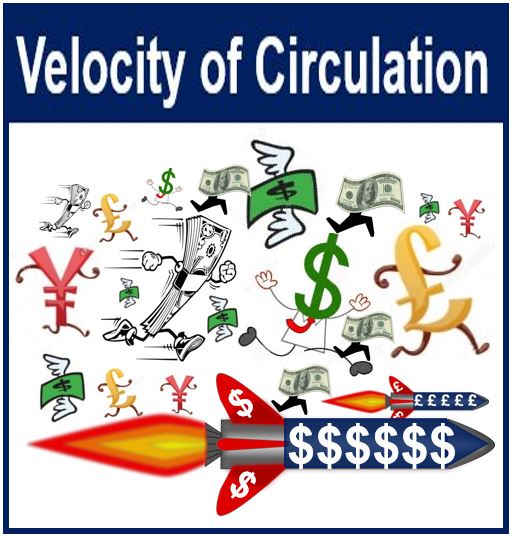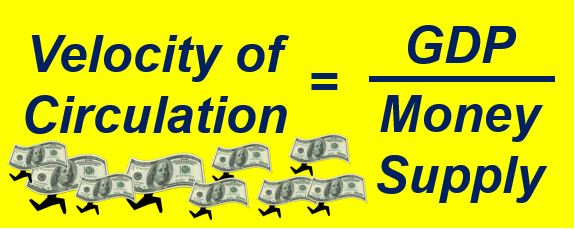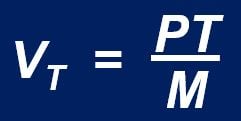What is velocity of circulation? Definition and meaning
The definition and meaning of velocity of circulation, also called the velocity of money or the velocity of circulation of money, refers to the amount of money that is circulating within the economy over a specified period – specifically, how fast it is moving. It is measured by dividing total output – or GDP (gross domestic product) – by the nation’s total money supply (amount of money available). The measure helps economists determine how healthy the economy is and whether prices will remain stable are start to rise.
Another way of looking at velocity of circulation of money, is that it is a calculation of the number of times it changes hands. It is a key ingredient of the Quantity Theory of Money.
In the United States, for example the velocity of money tells you how efficient $1 of money supply is at creating economic activity.
 Velocity of circulation refers to how rapidly money passes from one holder to the next.
Velocity of circulation refers to how rapidly money passes from one holder to the next.
According to economist, the higher the velocity of money – the faster money travels – and the more transactions in which it is used, the healthier the economy is. It means that its citizens are richer and the financial system is vibrant.
According to ft.com/lexicon, velocity of circulation is:
“The average number of times a unit of money changes hands in an economy during a given period – normally measured by dividing the total amount spent (GDP) by the amount of money available (money supply).
Velocity of circulation – inflation
When velocity of circulation is very high, it can be an indication of rising inflation – prices are increasing more rapidly than normal.
The velocity of circulation will pick up when banks start increasing their lending and spending rises.
– Bank Lending: when banks feel more confident about the economy’s current and future health, they will be willing to reduce their reserves and maintain a lower **reserve ratio. They will lend more money to individuals and businesses, which will mean that customers will spend money rather than leave it sitting in bank accounts.
** Reserve ratio is the proportion of depositors’ money that a bank holds in readily-available cash.
– Consumer spending: when there is an economic recovery, consumers spend money more frequently. Rather than saving it, they will purchase more goods and services, which speeds up the velocity of circulation.
When banks raise lending and consumers spend more, aggregate demand grows, which can cause inflationary pressures. It all depends on how rapidly spending grows and how much spare capacity there is in the economy.
If factories on average are producing well below their maximum capacity, they will be able to meet the increased demand by producing more. If however, demand exceeds their maximum capacity, they will push up their prices, i.e. there will be inflation.
Whether inflation grows and becomes a problem depends in large part on how the authorities, for example the central bank, manage the economic recovery.
If the US Federal Reserve, the Bank of England, the Bank of Japan, or the European Central Bank see a possible surge in inflationary pressures, they can start tightening up monetary policy. They can raise interest rates, which will dampen lending and spending.
An effective central bank should be able to manage an economic recovery without inflation getting out of hand. It is simply a question of making sure that the velocity of circulation does not increase too rapidly.
Calculating the velocity of circulation of money
The velocity of circulation refers to how often the money stock in an economy is used, over a specified time.
Calculating velocity of circulation is quite simple. It is:
 Velocity of Circulation equals GDP ÷ Money Supply
Velocity of Circulation equals GDP ÷ Money Supply
Imagine a country has a total of $1,000 billion of money in its economy, and the total value of all transactions for the the year is $1,000. The velocity of circulation is 1. Total money (GDP or total production) divided by the value of all transactions.
If another country also has a total of $1,000 billion of money, but the total value of transactions is $3,000, its velocity of circulation is 3.
In basic money supply, we have these abbreviations:
MV=PT
– M = Money Supply
– VT = Velocity of Circulation. Velocity of money for all transactions in a given time frame.
– P = Price Level
– T = Transactions. The aggregate real value of transactions in a given time frame.
In practice, attempts to measure the velocity of circulation are indirect. Transactions velocity is computed with the following formula:
 Transactions velocity formula
Transactions velocity formula
Thus, PT is the total nominal amount of transactions for a specific period. Values of PT and M permit calculation of VT.
Video – Velocity of circulation and inflation
This Khan Academy video explains why it is the velocity of circulation, here referred to as the velocity of money, that drives prices, rather than the quantity of money.

